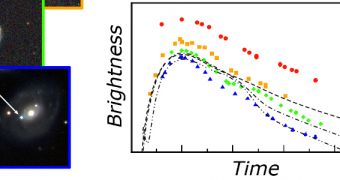An international team of scientists was able to determine in a new study that the masses of Type Ia supernovae vary greatly, even though the explosions themselves are triggered by the same mechanisms.
Less than two decades ago, astronomers discovered that the brightness of different Type Ia supernovae could be standardized to within 10 percent, a discovery that enabled two researchers to figure out how to use these explosions as a means of measuring distance in the Cosmos.
A team led by investigator Saul Perlmutter, from the US Department of Energy’s (DOE) Lawrence Berkeley National Laboratory (Berkeley Lab), and another led by Australian National University (ANU) expert Brian Schmidt, found 16 years ago that the Universe is expanding increasingly rapidly.
Their findings, which won them a Nobel Prize, are primarily based on studies of brightnesses and redshifts associated with Type Ia supernovae at a variety of locations across the Cosmos. The reason why these blasts were used as a landmark is their remarkable brightness similarity.
Unlike Type II supernovae, which occur in massive stars at least 8 times the mass of the Sun, Type Ia events occur when white dwarfs in binary systems explode. These dwarfs pack roughly one solar mass in a body the size of Earth. Until recently, astronomers thought that Type Ia explosions were all alike.
The chemical composition of white dwarf stars – which merge helium into heavier elements – is predominately accounted for by carbon and oxygen. Experts believed that the reason why these objects blow up was that they siphon mass from their stellar companions inside binary systems, or undergo a merger process with another white dwarf.
When the accreting white dwarf becomes nearly 40 percent more massive than the Sun – a threshold known as the Chandrasekhar limit – a runaway thermonuclear reaction was thought to occur that destabilized the star and led to its destruction. The fuel and the explosion mechanisms were therefore thought to be shared across all Type Ia supernova progenitor stars.
“The Chandrasekhar mass limit has long been put forward by cosmologists as the most likely reason why Type Ia supernovae brightnesses are so uniform, and more importantly, why they are not expected to change systematically at higher redshifts,” explains researcher Greg Aldering.
“The Chandrasekhar limit is set by quantum mechanics and must apply equally, even for the most distant supernovae,” he adds. Aldering, a cosmologist, leads the international Nearby Supernova Factory (SNfactory) at the Berkeley Lab Physics Division.
Another SNfactory member, Richard Scalzo, formerly a postdoctoral researcher at Berkeley Lab and currently based at ANU, demonstrates in the new study that normal Type Ia supernovae occur when their progenitor stars reach a range of masses, not just one. While most blasts occur when progenitors are near or slightly below the Chandrasekhar limit, 1 percent of stars explode after they exceed the limit.
“The white dwarfs exploding as Type Ia supernovae have a range of masses, and the resulting light-curve width is directly proportional to the total mass involved in the explosion,” says Aldering. Details of the new investigation have already been accepted for publication in an upcoming issue of the Monthly Notices of the Royal Astronomical Society.

 14 DAY TRIAL //
14 DAY TRIAL //